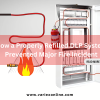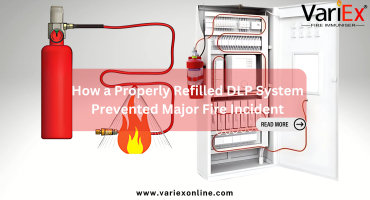![]()
Fire Immuniser
+91-7829629111
Email: info@variex.in
Varistor Technologies Pvt. Ltd.
Block-1, First Floor, Ardente Office One, Hoodi Circle, ITPL Main Road, Bengaluru, Karnataka 560048, IN
What Is Db Of Fire Alarm System
What Is Db Of Fire Alarm System
In the realm of fire protection and safety, fire alarm systems are indispensable components that play a crucial role in safeguarding lives and properties from the devastating effects of fire incidents. These systems are designed not only to detect fires at the earliest possible stage but also to alert occupants of the building to take appropriate action. One critical aspect often discussed concerning fire alarms is the decibel (dB) level. However, the concept of dB or decibel level in the context of fire alarm systems is vague to many. This article seeks to demystify this concept, taking readers through its meaning, relevance, regulations, and other pertinent considerations.
Understanding the Decibel (Db) in Fire Alarm Systems
The decibel (dB) is a unit of measurement used to express the intensity of sound. The level of noise that a fire alarm system generates is measured in decibels. The loudness level is often a balancing act between being audible enough to alert individuals, yet not so loud as to cause stress or harm to persons in the vicinity. It is important to note that the dB scale is logarithmic, meaning that an increase in ten decibels effectively doubles the perceived volume of the sound.
Importance of Decibel Level in a Fire Alarm System
The primary function of a fire alarm system is to notify occupants of a potential fire hazard, prompting evacuation or other appropriate action. The effectiveness of a fire alarm, therefore, largely depends on its ability to attract attention amidst any background noise or any physical conditions that challenge hearing. Thus, the dB level is not merely a technical aspect of the alarm but is intimately linked with the function and reliability of the alarm system as a whole.
Regulations Regarding Decibel Levels in Fire Alarm Systems
The regulatory standards for fire alarms, including the acceptable decibel levels, vary from one region to another. However, there are generally accepted guidelines put forth by certain reputable bodies, such as the National Fire Protection Association (NFPA) in the United States. According to NFPA 72, the National Fire Alarm and Signaling Code, audible fire alarms should have a minimum sound level of 75 dB at the pillow level in sleeping areas and 15 dB above the ambient sound level in occupied areas, usually not less than 60 dB. According to the World Health Organization (WHO), exposure to sound levels above 120 dB can be harmful, thereby necessitating a definite upper limit for fire alarm sound volumes.
Decibel Level and Fire Alarm System Design
The effective design of a fire alarm system not only entails suitable placement and number of alarm devices but also consideration of the sound characteristics in the property. Whether it's an open-plan retail store, a hotel with enclosed rooms, or an industrial factory buzzing with noisy equipment, the acoustic properties of the distinct spaces influence the reach and clarity of the alarm sound. As such, taking into account the dB level can ensure effective audibility of alarms amidst other competing sounds. Special attention must be given in areas with higher ambient noise levels, where louder alarms may be required, or in spaces that are structurally complex, where sound might not travel as efficiently.
Factors That Can Influence Decibel Level
Several factors can influence the dB level of a fire alarm system. The design and type of alarm sounders, the spacing and positioning of these devices, the acoustic properties of the building, and the ambient noise levels all contribute to the final alarm decibel output. For instance, open spaces and hard surfaces tend to reflect sound, increasing the effective volume, while soft materials and partitions can absorb sound and lower the dB level. Therefore, consideration of such factors is crucial during system design and installation to ensure compliance with the regulatory standards and effectiveness of the system.
Conclusion
Understanding the decibel level of fire alarm systems is essential to the effectiveness of the system and compliance with safety standards. It's more than a technical detail, but a key factor in ensuring that the primary function of a fire alarm, which is to alert people of a possible fire threat, is accomplished with efficiency and reliability. Despite variances in regional regulations, principles such as ensuring the alarm sound exceeds ambient noise levels and protecting individuals from excessively loud sounds are universal. As such, calculation and adjustment of the dB level should be intrinsic to the design, installation, and maintenance of any fire alarm system.
Final Say
At VariEx.in and VariexOnline.com, we specialize in supplying and installing top-quality fire fighting systems and equipment. From fire extinguishers to advanced suppression systems, we offer comprehensive solutions tailored to your needs. Our experienced team ensures precise installation and maintenance for optimal safety.
Trust VariEx for reliable fire protection. Contact us online or call 7829629111 to learn more.
"WHAT YOU CAN READ NEXT"
 Read more +24 November 2023 in Fire Extinguisher
Read more +24 November 2023 in Fire ExtinguisherWhat types of fire extinguishers are available for different fire classes?
 Read more +28 April 2025 in Fire Suppression
Read more +28 April 2025 in Fire SuppressionFire Suppression Refilling Checklist for Facility Managers
 Read more +25 April 2025 in Fire Suppression
Read more +25 April 2025 in Fire Suppression





